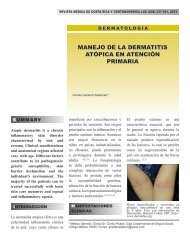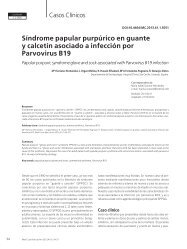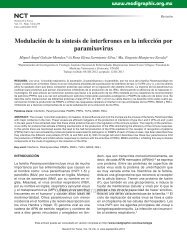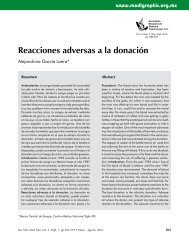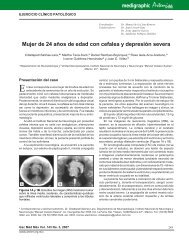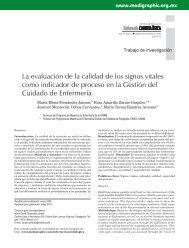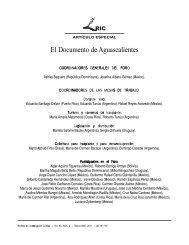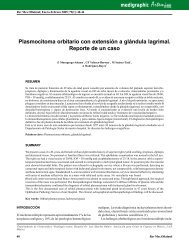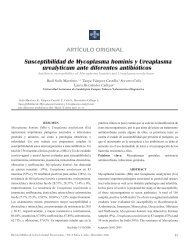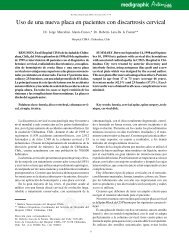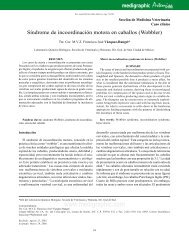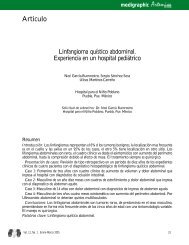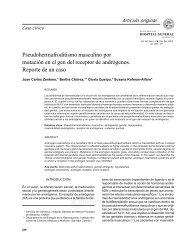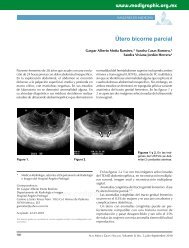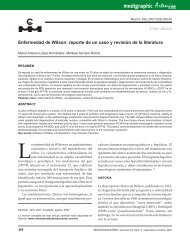Farmacología de los antitrombóticos - edigraphic.com
Farmacología de los antitrombóticos - edigraphic.com
Farmacología de los antitrombóticos - edigraphic.com
You also want an ePaper? Increase the reach of your titles
YUMPU automatically turns print PDFs into web optimized ePapers that Google loves.
<strong>Farmacología</strong> <strong>de</strong> <strong>los</strong> <strong>antitrombóticos</strong><br />
Las HBPM aprobadas por la FDA son: enoxaparina,<br />
dalteparina y tinzaparina. En México también se cuenta con<br />
nadroparina. Las dosis respectivas para la tromboprofilaxis<br />
son:<br />
Enoxiparina 1mg/Kg/24 horas<br />
Nadroparina 0.01 mL/Kg/24 horas<br />
Dalteparina 120 UI/Kg/24 horas<br />
Tinzaparina 120 UI/24 horas<br />
Estas dosis son las i<strong>de</strong>ales para la tromboprofilaxis con<br />
HBPM en sujetos con riesgo alto. Sin embargo, existen esquemas<br />
simplificados y efectivos para el uso <strong>de</strong> estos <strong>antitrombóticos</strong><br />
en ciertas situaciones especiales: cirugía general y abdominal,<br />
cirugía ortopédica y <strong>los</strong> pacientes con patología médica. Estos<br />
esquemas simplificados se abordan en <strong>los</strong> capítu<strong>los</strong> correspondientes.<br />
Fondaparinux<br />
También llamado pentasacárido, es más pequeño que la<br />
HBPM. Tiene mayor biodisponibilidad y vida media y un efecto<br />
más consistente aunque el riesgo <strong>de</strong> hemorragia es mayor. La<br />
dosis re<strong>com</strong>endada es <strong>de</strong> 2.5 mg/24 horas. 17,18 Sus indicaciones<br />
abarcan la tromboprofilaxis en cirugía y medicina interna<br />
pero se ampliaron recientemente, incluso, hasta el tratamiento<br />
<strong>de</strong> la tromboembolia pulmonar,<br />
Referencias<br />
1. Majluf-Cruz A, García-Chávez J, Martínez-Murillo C. Enfermedad<br />
tromboembólica venosa. 1ª Edición, 2005. Editorial Garmarte.<br />
2. Mammen EF. Current <strong>de</strong>velopment in antithrombotic therapy. Sem Thromb<br />
Haemost 2004;6:605-607.<br />
3. Walenga J, Hoppensteadt D. Monitoring the new antithrombotic drugs. Sem<br />
Thromb Haemost 2004;6:683-695.<br />
4. Lobato-Mendizabal E, Majluf-Cruz A. Thrombophilia, thromboembolism and<br />
the use of the unfractionated and low-molecular-weight heparins. Rev Invest<br />
Clin 2000;52:529-545.<br />
5. Weitz J, Hirsh J, Samama M. New anticoagulant drugs. The Seventh ACCP<br />
Conference on Antithrombotic and Thrombolytic Therapy. Chest 2004;126:265S–<br />
286S.<br />
6. Dolovich LR. Ginsberg JS, Douketis JD, Holbrook AM, Cheah G. A metaanalysis<br />
<strong>com</strong>paring low-molecular-weight heparins with unfractionated heparin<br />
in the treatment of venous thromboembolism: Examining some unanswered<br />
questions regarding location of treatment, product type, and dosing frequency.<br />
Arch Intern Med 2000;160:181-188.<br />
7. Warkentin TE. Heparin-induced thrombocytopenia: Pathogenesis and<br />
management. Br J Haematol 2003;121:535-555.<br />
8. Buller HR, Agnelli G, Hull RD, Hyers TM, MD, Prins MH, et al. Antithrombotic<br />
therapy for venous thromboembolic disease. The Seventh ACCP Conference<br />
on Antithrombotic and Thrombolytic Therapy. Chest 2004;126:401S-428S.<br />
9. Buller HR, Davidson BL, Decousus H, Gallus A, Gent M, Piovella F, et al.<br />
Fondaparinux or enoxaparin for the initial treatment of symptomatic <strong>de</strong>ep<br />
venous thrombosis. Ann Intern Med 2004;140:867-873.<br />
10. Hainer J, Per Sprogel P, Lin<strong>de</strong>nstroem E. An example based on the lowmolecular<br />
weight heparin, tinzaparin. Sem Thromb Haemost 2004;30(Suppl):3-<br />
9.<br />
11. An<strong>de</strong>rson JC. Advances in anticoagulation therapy: The role of selective<br />
inhibitors of factor Xa and thrombin in thromboprophylaxis after major orthopedic<br />
surgery. Sem Thromb Haemost 2004;6:609-618.<br />
12. Martínez-Murillo C, Quintana-González S, Ambriz-Fernán<strong>de</strong>z R, Hernán<strong>de</strong>z<br />
PM. El problema trombótico. Hematología 2000;1:17-20.<br />
13. Martínez-Murillo C. Hacía un consenso nacional <strong>de</strong> tromboembolismo venoso.<br />
Gac Med Mex 2000;136:133-137.<br />
14. Kaboli P, Hen<strong>de</strong>rson MC, White RH. DVT prophylaxis and anticoagulation in<br />
the surgical patient. Clin Med North Am 2003;87:77-110.<br />
15. San<strong>de</strong>rink GJ, Liboux AL. The pharmacokinetics and pharmacodynamics of<br />
enoxaparin in obese volunteers. Clin Pharmacol Ther 2002;72:308-318<br />
16. Carrillo Esper R, Carrillo Córdova JR. Profilaxis <strong>de</strong> la enfermedad tromboembólica<br />
venosa en cirugía y anestesiología. Editorial Alfil, México DF, 2005.<br />
17. Cohen AT, Davidson BL, Gallus AS, Lassen MR, Prins MH, Tomkowski W,<br />
et al. Efficacy and safety of fondaparinux for the prevention of venous<br />
thromboembolism in ol<strong>de</strong>r acute medical patients: Randomised placebo controlled<br />
trial. BMJ 2006;332:325-329.<br />
18. McRae SJ, Ginsberg JS. New anticoagulants for venous thromboembolic<br />
disease. Curr Opin Cardiol 2005;20:502-508.<br />
28 Gac Méd Méx Vol. 143 Supl 1, 2007



